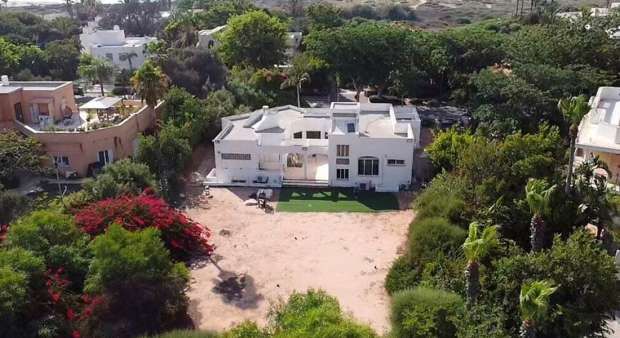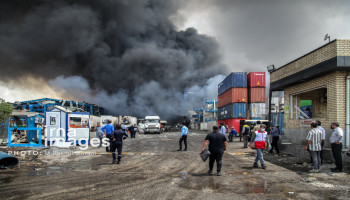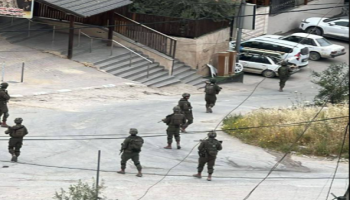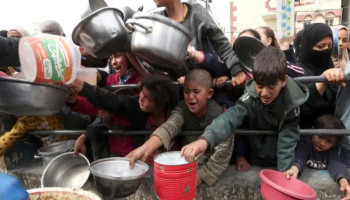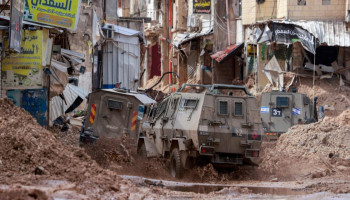On Saturday, the Islamic Resistance in Lebanon, Hezbollah, escalated its offensive against illegal settlements in northern occupied Palestine, launching over 200 rockets, according to Hebrew media reports. As the Israeli genocide war on Gaza entered its 379th day, the office of the Zionist Prime Minister confirmed that “a drone launched from Lebanon directly struck the residence of Benjamin Netanyahu in Caesarea.”
Hebrew sources verified that “the drone that hit Netanyahu’s home in Caesarea exploded despite enemy military helicopters pursuing it the entire time,” while a source from Netanyahu’s office claimed that “the Prime Minister and his wife were not at home when the drone detonated.”
Following the attack on Netanyahu’s residence, Israeli media reported an increased state of alert around key government figures. The drone that struck Caesarea was reportedly of the same type that previously targeted the Golani Brigade's camp, known for being difficult to intercept.
The "Wall Street Journal" quoted a Zionist intelligence official who confirmed that Hezbollah’s drone strikes have resumed forcefully after a relatively long hiatus, noting that "Israel is facing challenges in countering them."
The" Israeli Home Front Command" reported that sirens sounded across Haifa, its bay, and around 40 other locations in northern occupied Palestine, prompting two million settlers to take refuge in shelters. Reports indicate that Hezbollah launched a large-scale attack using both rockets and drones.
The Entity's Military Situation and General Stance
On the battlefield, all signs point to an ongoing military pause by the entity's army of five divisions stationed in northern occupied Palestine, which has reduced 80% of its readiness since last Thursday following a failed ground invasion attempt from “Shebaa to Naqoura.”
In the past 24 hours, no reports of infiltration or engagement emerged from three of the five main fronts extending from (Naqoura to Shebaa Farms and Kfar Shuba Hills), due to the heavy losses incurred by Israeli forces attempting to break through the seven secondary fronts.
Hebrew reports identified these secondary fronts as: (Naqoura – Mushayrifa – Labouna), (Aita al-Shaab – Ramya al-Qawzah), (Avivim – Marun al-Ras and Avivim – Yaron), (Blida – Mais al-Jabal), (Markaba – Adaisseh – Rubb Thalathin – Al-Taybeh project), (Kafr Kela), and (Shebaa Farms – Shebaa and Habariya).
A Hebrew report noted that in sectors overseen by the "36" and "146" divisions, Israeli forces were deployed in a manner suggesting the two divisions had merged under a unified command, forming an operational corps-like structure.
Since October 4, the "98" and "91" divisions have been working in tandem, and the "36" and "146" divisions have been engaged in the “Triangle of Death” operations (Ramya – Aita al-Shaab – al-Qawzah). Fierce battles have revealed casualties among members of the "Sayeret Golani" Battalion (Battalion 631).
Field data indicates that on Friday evening, the armored battalion 74 of Brigade 188 was added to preparations for a sixth attempt to penetrate the “Triangle of Death,” aiming to reach “al-Qawzah” with its strategically elevated terrain.
Observers noted that the entity's forces employed several tactics in their attempts to breach these areas, but were successfully thwarted by highly trained defenders capable of adapting flexibly to various combat scenarios, whether confronting small units or full battalions, as seen in the "Eastern Death Square" (Al-Taybeh Project – Rubb Thalathin – Markaba – Hula).
Combat Developments in the Last 24 Hours
Analysis of military reports and media coverage over 24 hours indicates that "Sector Five of Division 210" of the Israeli army witnessed several skirmishes without any significant advances, despite intense pressure from the Zionist air force.
In "Sector Four of Division 98," Hezbollah fighters foiled an infiltration attempt near the "Kafr Kela – Adaisseh" international border crossing after the occupying forces entered through a breach in the separation wall. Hezbollah fighters engaged in several close-quarters firefights.
Indirect combat continued in "Sector Three of Division 91" near Rubb Thalathin and Markaba, with no new infiltrations or incursions, but a sustained exchange of artillery and rocket fire. The enemy army conducted heavy airstrikes in the area (Al-Taybeh – Mais al-Jabal – Hula – Talusa – Bani Hayyan – Deir Siryan, extending to Zawtar, Mahmoudiya, and Kafr Tibnit).
In "Sector Two of Division 36," Hebrew reports noted that the entity forces deployed in preparation for what appeared to be an attempt to occupy "Marun al-Ras and Yaron" as a prelude to launching a larger offensive towards the city of "Bint Jbeil." However, the forces were discouraged just before execution.
Meanwhile, in "Sector One of Division 146," Israeli operations in the Triangle of Death (Aita al-Shaab – Ramya – al-Qawzah) significantly decreased after six days of continuous attempts to penetrate Aita al-Shaab and Ramya toward “al-Qawzah Monastery.” Israeli forces deployed two battalions (Battalion 631, "Egoz," and Battalion 74, armored) to this front.
Reports from "Labouna, Mushayrifa, Naqoura" indicate that Israeli army clashes have largely subsided, reduced to artillery and rocket exchanges, as seen in Shebaa.
Hezbollah’s Tactical Operations
Analysis of Hezbollah’s military activities over 24 hours reveals a wide range of tactics and geographical focus in both defensive and offensive operations. In response to Israeli aggression and massacres against civilians, Hezbollah conducted over 20 operations, including a major rocket barrage targeting the Nasher military base east of Haifa.
Hezbollah also attacked enemy military concentrations in several settlements, including "Shlomi, al-Bassa, Kiryat Shmona, al-Marj, Zar’it, al-Malikiyah, and Jall al-Deir," employing a mix of rocket salvos and various weapons.
Hebrew media reported a rocket strike, killing one settler and wounding others. Several rockets also hit factories, and 21 soldiers were injured by rocket fire in the Western Galilee and “Krayot.” Approximately 20 rockets were launched towards “Krayot” in the latest salvo from Lebanon.
Delivering Painful Blows to Israel
Hezbollah’s operations reveal a high degree of military coordination and sophistication in their tactics. By expanding its strikes to include sensitive Israeli enemy targets, Hezbollah has demonstrated a significant evolution in its capabilities. These operations underscore Hezbollah’s determination to retaliate for the Zionist aggression, signaling to the entity that any future attack on Lebanon will be met with a decisive response.

